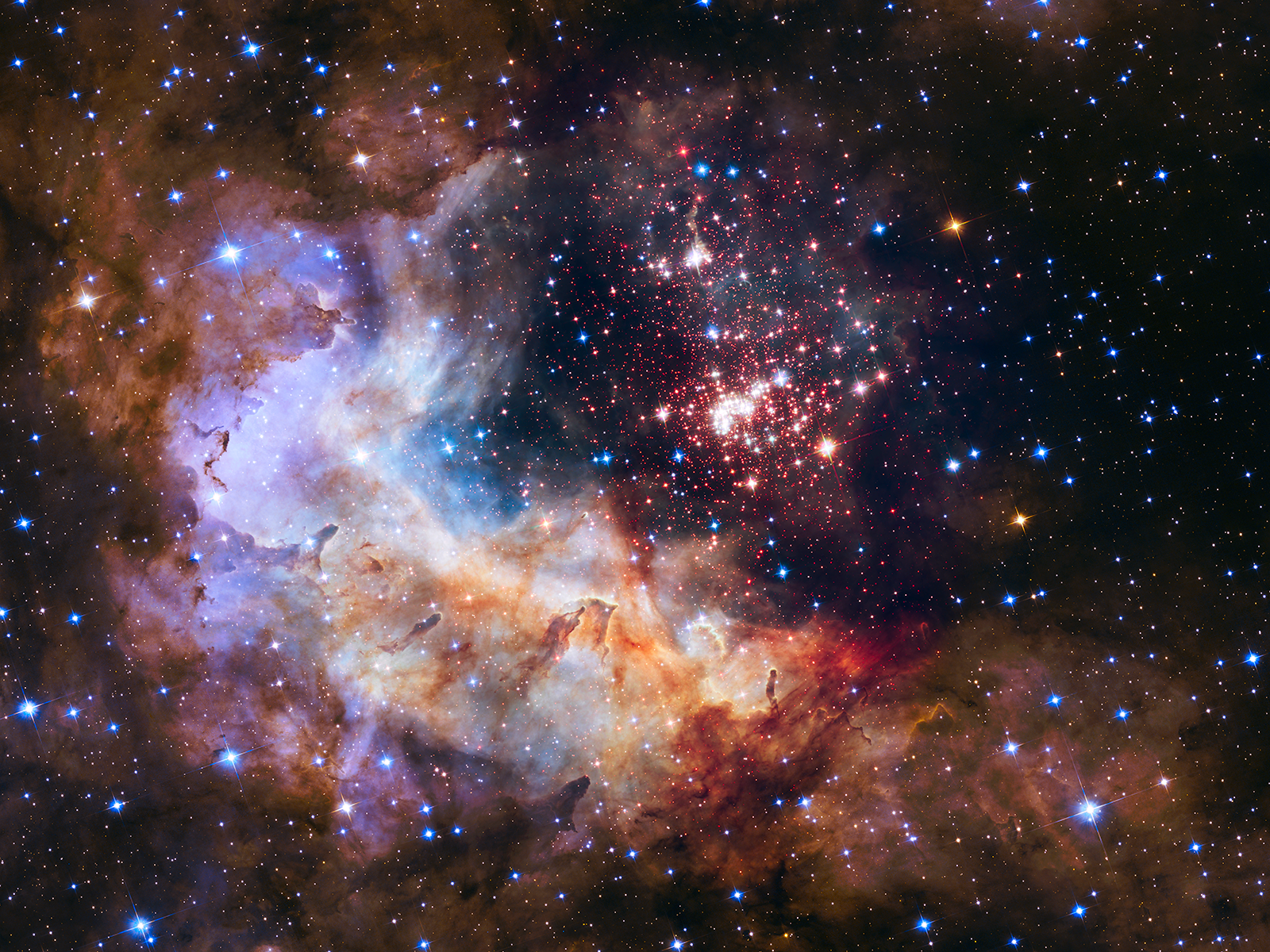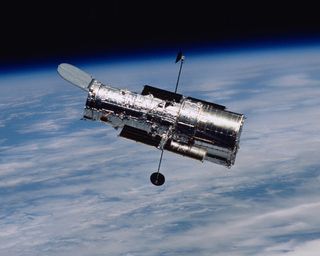NASA Unveils Spectacular Photo for Hubble Telescope's 25th Birthday

An awe-inspiring landscape of multicolored dust and jewel-like stars has been unveiled as the official image of the 25th anniversary of the Hubble Space Telescope.
More than 3,000 stars, radiating like cosmic fireworks, lie near the center of the epic new image. The stellar cluster is known as Westerlund 2. The colorful gas cloud to the left of the star cluster is a hotbed of stellar birth known as Gum 29, located 20,000 light-years away from Earth in the constellation Carina. You can take a video tour of the new Hubble image, courtesy of the Space Telescope Science Institute, NASA and the European Space Agency.
"Hubble has completely transformed our view of the universe, revealing the true beauty and richness of the cosmos," said John Grunsfeld, astronaut and associate administrator of NASA's Science Mission Directorate, in a statement from NASA. "This vista of starry fireworks and glowing gas is a fitting image for our celebration of 25 years of amazing Hubble science." [Hubble Telescope at 25: A Photo Celebration]
The anniversary image was revealed today (April 23) during a Hubble celebration event at the Newseum in Washington, D.C. Speakers at the event included NASA Administrator Charlie Bolden, NASA Associate Administrator for the Science Mission Directorate John Grunsfeld, Hubble Senior Project Scientist Jennifer Wiseman and Space Telescope Science Institute Interim Director Kathryn Flanagan.
The image of Westerlund 2 is a blend of visible light captured by Hubble's Advanced Camera for Surveys, and near-infrared light taken by the Wide Field Camera 3. The infrared eyes of the Wide Field Camera 3 are able to peer through the dust that shrouds this region, according to the NASA statement. The Wide Field Camera 3 was installed on the observatory in 2009 by astronauts on the fifth Hubble repair mission.
"The [Westerlund 2] cluster measures between 6 and 13 light-years across," according to the NASA statement. "The giant star cluster is about 2 million years old and contains some of our galaxy's hottest, brightest and most massive stars."
Get the Space.com Newsletter
Breaking space news, the latest updates on rocket launches, skywatching events and more!
The gaseous region around the star cluster was also captured with the Advanced Camera for Surveys, and some of the colors in the image indicate the composition of the gas: shades of red represent hydrogen, and bluish-green represents areas that contain oxygen.
Nearby stars form the peculiar architecture that is seen in the gas cloud, such as the pointy pillars. The stellar winds emitted by these stars collide with the gas clouds and spark new star formation.
"The red dots scattered throughout the landscape are a rich population of newly forming stars still wrapped in their gas-and-dust cocoons," the statement said. "These tiny, faint stars are between 1 million and 2 million years old — relatively young stars — that have not yet ignited the hydrogen in their cores. The brilliant blue stars seen throughout the image are mostly foreground stars."
This region of space is of great interest to astronomers because it is a relatively young stellar incubator. Many of the young or embryonic stars seen in the image will grow into adulthood and be dispersed deep into interstellar space. But right now, this stellar nursery provides astronomers with information about how stars and star clusters form in the universe. (Hubble has helped scientists image many other star birth centers)

The Hubble Space Telescope launched into space on April 24, 1990. It continues to make observations of the cosmos, and may continue to operate into 2020 or beyond.
Follow Calla Cofield @callacofield.Follow us @Spacedotcom, Facebook and Google+. Original article on Space.com.
Join our Space Forums to keep talking space on the latest missions, night sky and more! And if you have a news tip, correction or comment, let us know at: community@space.com.

Calla Cofield joined Space.com's crew in October 2014. She enjoys writing about black holes, exploding stars, ripples in space-time, science in comic books, and all the mysteries of the cosmos. Prior to joining Space.com Calla worked as a freelance writer, with her work appearing in APS News, Symmetry magazine, Scientific American, Nature News, Physics World, and others. From 2010 to 2014 she was a producer for The Physics Central Podcast. Previously, Calla worked at the American Museum of Natural History in New York City (hands down the best office building ever) and SLAC National Accelerator Laboratory in California. Calla studied physics at the University of Massachusetts, Amherst and is originally from Sandy, Utah. In 2018, Calla left Space.com to join NASA's Jet Propulsion Laboratory media team where she oversees astronomy, physics, exoplanets and the Cold Atom Lab mission. She has been underground at three of the largest particle accelerators in the world and would really like to know what the heck dark matter is. Contact Calla via: E-Mail – Twitter